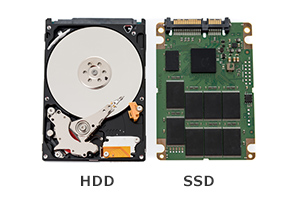Basic Knowledge of Industrial Computers (Storage)
SSD (Solid State Drive) and HDD (Hard Disk Drive)
SSD is an acronym for Solid State Drive. SSDs are storage devices that record computer data. Although they are used in the same way as HDDs (Hard Disk Drive), SSDs use a different mechanism than HDDs to read and write data. HDDs move a magnetic head over a rapidly spinning magnetic disk in order to read and write data. The advantages of HDDs include availability of products with larger storage capacity than SSDs, and lower prices per memory unit. However, the disadvantages include drive lifetimes that are limited because they use spindles (motors) with limited lifespans, and also vulnerability to vibration and impact. On the other hand, SSDs are spindleless devices that read and write data logically to/from semiconductor elements (NAND flash memory). Their advantages include resistance to vibration and impact, silent operation, and low power consumption. However, the disadvantages of SSDs are that they have higher prices per memory unit than HDDs, and have maximum rewrite lifetimes due to deterioration of the semiconductor elements caused by repeatedly writing data. The rewrite lifetime varies depending on the semiconductor element as shown in the table below.

Type of SSD (Solid State Drive) and rewrite lifetime
CMR (Conventional Magnetic Recording) and SMR (Shingled Magnetic Recording)
In contrast to SMR, CMR (Conventional Magnetic Recording) is the conventional method for recording data where gaps are left in the recording tracks to prevent overlap. With the introduction of SMR, this conventional data recording method came to be known as CMR to differentiate it with SMR. CMR is better suited to reading and writing noncontiguous memory space (random access) compared to SMR, and allows for extended periods of use without experiencing speed drops.
SMR (Shingled Magnetic Recording) is a recording method that increases recording density by overlapping parts of a track used to record data much like tiles on a house roof. This allows for a large recording capacity at a low cost. This is ideally suited to applications involving extensive reading and writing of contiguous memory space, such as NVR (network video recorders), security camera and surveillance camera video recordings, and data loggers. SMR is not suited to reading and writing noncontiguous memory space (random access), and suffers from speed degradation after extended use. It is also not suited to RAID configurations.
To PageTop